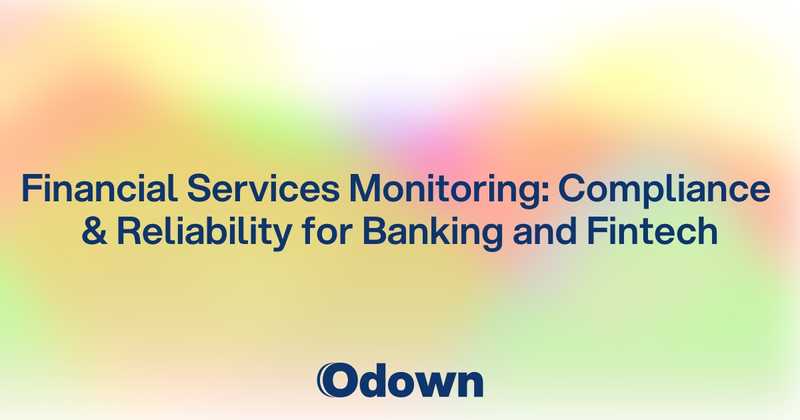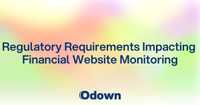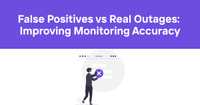Financial Services Monitoring: Compliance and Reliability for Banking and Fintech
Your payment processing system went down for twelve minutes during market hours. Technically, you met your 99.9% uptime SLA. Your monitoring dashboards show that the outage was brief and services recovered automatically. But those twelve minutes blocked $50 million in transactions, triggered regulatory reporting requirements, and created compliance violations that will take months to resolve.
Welcome to financial services monitoring, where traditional uptime metrics miss the business and regulatory realities of handling money. In financial services, monitoring isn't just about keeping systems running - it's about protecting customer funds, maintaining market integrity, ensuring regulatory compliance, and managing systemic risk that extends far beyond your organization.
Financial services monitoring requires understanding that every system failure has legal, regulatory, and financial implications that don't exist in other industries. You need monitoring approaches that account for strict regulatory requirements, zero-tolerance reliability expectations, and security threats that target financial data and transactions specifically.
Regulatory Requirements: SOX, PCI-DSS, and Financial Industry Standards
Financial services monitoring must satisfy multiple overlapping regulatory frameworks that impose specific requirements for system oversight, data protection, and incident reporting.
Sarbanes-Oxley (SOX) Compliance Monitoring
SOX compliance requires extensive monitoring of financial reporting systems and controls that ensure accurate financial disclosures and prevent fraudulent financial reporting.
Internal controls monitoring tracks the effectiveness of controls that prevent unauthorized access to financial data and systems that affect financial reporting accuracy.
Change management monitoring ensures that all modifications to systems affecting financial reporting follow proper approval procedures and maintain audit trails.
Access control monitoring tracks who can access financial reporting systems and ensures that access permissions align with job responsibilities and segregation of duties requirements.
Data integrity monitoring validates that financial data remains accurate and complete throughout processing workflows and storage systems.
Audit trail monitoring maintains comprehensive logs of all activities affecting financial reporting systems to support internal audits and external examinations.
PCI-DSS Payment Card Industry Standards
PCI-DSS compliance requires comprehensive monitoring of systems that process, store, or transmit payment card data to prevent data breaches and maintain cardholder data security.
Cardholder data environment monitoring tracks all systems that handle payment card information and ensures they maintain appropriate security controls.
Network segmentation monitoring validates that payment card systems remain properly isolated from other network segments that might introduce security vulnerabilities.
Vulnerability management monitoring tracks security patch installation, vulnerability scanning results, and remediation progress for systems handling cardholder data.
Access control monitoring for PCI environments requires detailed tracking of administrative access, authentication attempts, and privilege usage for systems handling payment data.
File integrity monitoring detects unauthorized changes to critical system files and configurations that could indicate security breaches or compliance violations.
Financial Industry Regulatory Authority (FINRA) Requirements
FINRA regulations require monitoring of trading systems, customer communications, and market data handling for securities industry participants.
Trade surveillance monitoring tracks trading activity patterns to detect potential market manipulation, insider trading, or other regulatory violations.
Customer communication monitoring tracks and archives customer interactions including emails, instant messages, and phone calls as required by regulatory record-keeping requirements.
Market data monitoring ensures that financial market data displays accurately and remains synchronized across different systems and client interfaces.
Best execution monitoring tracks order routing and execution quality to ensure compliance with best execution requirements for customer orders.
Anti-money laundering (AML) monitoring tracks transaction patterns and customer behavior to identify potentially suspicious activities that require regulatory reporting.
Basel III and Risk Management Standards
Basel III regulations require comprehensive monitoring of risk exposures, capital adequacy, and liquidity positions for banking institutions.
Credit risk monitoring tracks loan portfolios, counterparty exposures, and credit quality metrics that affect capital requirements and regulatory ratios.
Market risk monitoring tracks trading positions, value-at-risk calculations, and market exposure concentrations that affect capital requirements.
Operational risk monitoring tracks operational failures, control breakdowns, and loss events that affect capital allocation and regulatory reporting.
Liquidity risk monitoring tracks funding sources, asset liquidity, and cash flow projections that affect regulatory liquidity ratios and stress testing requirements.
High-Availability Monitoring for Critical Financial Systems
Financial services systems require reliability levels that exceed typical enterprise applications because system failures can affect market operations, customer funds, and regulatory compliance.
Zero-Downtime Architecture Monitoring
Financial systems often require continuous operation without planned downtime, necessitating monitoring approaches that support zero-downtime deployments and maintenance.
Active-active system monitoring tracks multiple concurrent systems that handle production traffic simultaneously to ensure seamless failover capabilities.
Database replication monitoring ensures that financial data remains synchronized across multiple database instances without introducing data inconsistencies.
Load balancing effectiveness monitoring validates that traffic distributes properly across redundant systems and that failover mechanisms work correctly under load.
Geographic redundancy monitoring tracks system performance across multiple data centers or cloud regions to ensure business continuity during regional outages.
Disaster recovery monitoring validates that backup systems can assume production workloads within regulatory requirements for maximum acceptable downtime.
Real-Time Transaction Processing Monitoring
Financial transaction processing requires real-time monitoring because delays can affect market operations and create regulatory compliance issues.
Transaction throughput monitoring tracks system capacity to process transactions and identifies bottlenecks that might cause processing delays during peak periods.
Message queue monitoring tracks transaction message processing to ensure that financial transactions complete in proper sequence without loss or duplication.
Settlement monitoring tracks the completion of financial transactions and ensures that funds transfer correctly between accounts and institutions.
Reconciliation monitoring validates that transaction records match across different systems and identifies discrepancies that might indicate processing errors.
Latency monitoring tracks transaction processing times to ensure that systems meet performance requirements for real-time financial operations.
Regulatory Uptime Requirements
Financial regulators often impose specific availability requirements that exceed general industry standards and require specialized monitoring approaches.
SLA monitoring tracks system availability against regulatory requirements and identifies when availability falls below mandated levels that trigger reporting obligations.
Planned maintenance monitoring ensures that scheduled system maintenance follows regulatory approval procedures and doesn't violate availability requirements.
Incident escalation monitoring tracks how quickly teams respond to system failures and whether response times meet regulatory expectations for critical system recovery.
Business continuity monitoring validates that alternate processing capabilities can maintain essential services during primary system outages.
Transaction Monitoring: Ensuring Payment and Trading System Reliability
Financial transaction monitoring requires specialized approaches that account for the unique characteristics of monetary transactions and trading operations.
Payment System Monitoring
Payment systems require monitoring that ensures transaction accuracy, prevents fraud, and maintains compliance with payment industry regulations.
Payment authorization monitoring tracks the success rates and response times of payment authorization requests across different payment methods and processors.
Settlement timing monitoring ensures that payment settlements complete within required timeframes and identifies delays that might affect cash flow or regulatory compliance.
Payment routing monitoring tracks how payments move through different processing networks and identifies routing issues that might affect transaction success rates.
Currency conversion monitoring tracks foreign exchange rate application and ensures that currency conversions calculate correctly for international payments.
Payment fraud monitoring integrates with transaction processing to detect potentially fraudulent payments without creating excessive friction for legitimate transactions.
Trading System Monitoring
Securities trading systems require specialized monitoring because trading failures can affect market integrity and create significant financial liability.
Order management monitoring tracks trade order lifecycle from submission through execution and settlement to ensure accurate trade processing.
Market data feed monitoring ensures that trading systems receive accurate and timely market data required for fair and orderly trading operations.
Trade execution monitoring tracks execution quality and ensures that trades execute at appropriate prices and within regulatory best execution requirements.
Position monitoring tracks trading positions in real-time to ensure accurate risk calculations and compliance with position limits and margin requirements.
Trade reporting monitoring ensures that trade information reports to regulatory systems accurately and within required timeframes.
Cross-Border Transaction Monitoring
International financial transactions require monitoring that accounts for multiple regulatory jurisdictions and currency conversion complexities.
Sanctions screening monitoring ensures that international transactions comply with economic sanctions and blocked party lists across relevant jurisdictions.
Anti-money laundering monitoring for cross-border transactions tracks transaction patterns that might indicate money laundering or terrorist financing activities.
Foreign exchange monitoring tracks currency conversion accuracy and ensures compliance with foreign exchange regulations in relevant jurisdictions.
Correspondent banking monitoring tracks relationships with foreign financial institutions and ensures compliance with due diligence requirements.
Financial Services Security Monitoring: Fraud Detection and Prevention
Financial services face unique security threats that target customer funds and sensitive financial data, requiring specialized security monitoring approaches.
Fraud Detection and Prevention
Financial fraud monitoring requires real-time analysis of transaction patterns and customer behavior to identify potentially fraudulent activities without creating excessive customer friction.
Behavioral analytics monitoring establishes baseline patterns for individual customers and identifies deviations that might indicate account compromise or fraudulent activity.
Transaction velocity monitoring tracks the frequency and amounts of transactions to identify unusual patterns that might indicate fraud or money laundering.
Device fingerprinting monitoring tracks customer device characteristics to identify when accounts are accessed from unexpected devices or locations.
Geolocation monitoring tracks customer transaction locations and identifies transactions that occur from unexpected geographic locations or impossible travel patterns.
Machine learning fraud detection monitoring uses artificial intelligence to identify complex fraud patterns that rule-based systems might miss.
Cybersecurity Threat Monitoring
Financial institutions face sophisticated cyber threats that require advanced security monitoring capabilities and rapid incident response.
Advanced persistent threat (APT) monitoring identifies long-term, stealthy attacks that target financial institutions for data theft or system disruption.
Network traffic analysis monitors financial networks for signs of unauthorized access, data exfiltration, or command-and-control communications.
Endpoint security monitoring tracks workstations and servers used by financial services employees to identify malware infections or unauthorized activities.
Privileged account monitoring tracks administrative access and identifies potentially malicious activities by users with elevated system privileges.
Data loss prevention monitoring identifies attempts to exfiltrate sensitive financial data or customer information through various communication channels.
Regulatory Security Reporting
Financial services security monitoring must support regulatory reporting requirements that mandate disclosure of security incidents and control effectiveness.
Incident classification monitoring ensures that security incidents receive appropriate classification and reporting based on regulatory requirements and impact assessments.
Breach notification monitoring tracks data breaches and ensures that notification requirements are met within regulatory timeframes.
Control effectiveness monitoring validates that security controls operate effectively and identifies control failures that might require regulatory reporting.
Threat intelligence monitoring tracks emerging threats that might affect financial institutions and ensures that security controls adapt to evolving threat landscapes.
Security metrics monitoring tracks key security indicators required by regulatory examinations and board reporting requirements.
Financial services monitoring transforms system oversight from technical operations into business risk management that protects customer funds, maintains market integrity, and ensures regulatory compliance. Instead of just keeping systems running, you maintain the trust and stability that financial markets require.
The investment in comprehensive financial services monitoring pays dividends in reduced regulatory risk, improved customer trust, and protection against the financial and reputational damage that system failures can cause in the financial services industry.
Ready to implement financial services monitoring? Odown provides enterprise-grade monitoring with the reliability, security, and compliance capabilities that financial institutions require. Combined with our DevOps monitoring strategies, you'll have complete visibility into both your operational infrastructure and the regulatory compliance requirements that govern financial services technology.



